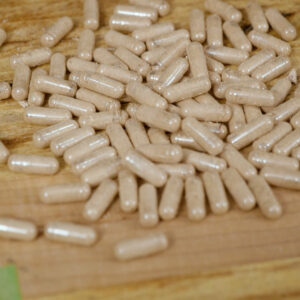
DIY Beef Liver Supplements
You've no doubt heard about the benefits of beef liver. Maybe you've even purchased beef liver supplements before. But now, with fresh (or frozen) liver in hand, you're ready to make your own. Follow this step-by-step tutorial for making freeze-dried or dehydrated beef liver supplements.
Equipment
- Freeze Dryer or Dehydrator
- 2 Mason Jars for storing beef liver powder and capsules
- Capsule Machine
- Capsules make sure you get the correct size for your machine
Ingredients
- 1 beef liver sliced or diced
Instructions
Prepare the Liver
- Slice the liver into uniform pieces. If using a freeze-dryer, make sure the size of the pieces doesn't extend above the height of the freeze-dryer trays. I cut mine into long, skinny pieces. If using a dehydrator, I recommend cutting them into smaller pieces, as uniformly as possible, so they dehydrate evenly.
- Arrange your liver pieces onto your freeze-dryer or dehydrator trays. You can line them with silicone sheets or dehydrator sheets. This may be necessary for some dehydrator trays if the pieces of liver are small enough to fall through the tray (remember, the dehydrated liver pieces will shrink a bit – you don't want to end up with liver pieces all over the bottom of your dehydrator).
Freeze Dry or Dehydrate
- Freeze-Drying: Place the trays of sliced liver into the freeze dryer and manually adjust the settings. I like to add two hours of extra dry time and adjust the temperature to 145° F. My liver took 36 hours to freeze dry. Depending on the size of your liver pieces, it may take more or less time. Make sure the liver is completely freeze-dried before moving on to the next step. It shouldn't feel cold to the touch and should snap in half (not bend) when folded.
- Dehydrating Liver: Set the trays of liver in the dehydrator at 145° F. Check the liver after 12 hours and then every couple of hours until fully dehydrated. When fully dehydrated, the liver should be hard, not soft or bendable. You can check for moisture by allowing the liver to cool to room temperature and then placing the pieces in a sealed jar. If any condensation forms on the inside of the jar, you know the liver is not fully dehydrated. Put it back into the dehydrator and continue drying.
Powder Liver
- Once the liver is either dehydrated or freeze-dried, it's time to powder it. You can use a high-powered blender, food processor, or even a coffee or spice grinder for this step. Pro Tip: If you prefer extra fine powder, you can sift it through a fine mesh sieve, but I find picking out the larger pieces by hand is fastest.
Make Capsules
- Following the instructions that came with your capsule maker, you'll now want to fill and secure your capsules. My Capsule It machine holds 100 “00”-sized capsules. The machine has a side for the “bottom” capsules and a side for the “lids.” Once the bottoms are filled with liver powder, tamped down, and then filled again (until they're filled), I add the top capsules and press down to add the lids.
Notes
Storing Instructions:
- Store the extra liver powder in a Mason jar. If you have a large amount, like me, and won't be using it up within a month, you will want to add a desiccant packet to your jar, then vacuum seal the lid each time you open it.
- Store pills in a jar with or without a desiccant powder (depending on how humid your area is).
Tried this recipe?Let us know how it was!